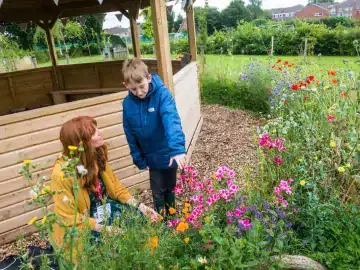
Making zines for nature
Zines are DIY or self-published magazines or publications – and can be a simple, creative way to break down and communicate complex issues and facilitate discussion, providing children and young people with a chance to share what matters to them.
Why not use this activity as a starting point to bring together the things you have collectively discovered and learned so far throughout the Nature Park programme? Zines can be a great reflective and evaluative tool for learners, as well as demonstrating how small actions can add up to create a big difference.
Preparation
What you need
- Paper – A4/A3 white paper, coloured paper, recycled scraps or offcuts
- Magazines, leaflets and newspapers for collaging – can you gather any garden or nature-focused magazines or catalogues?
- Craft materials and tools: pens and pencils, glue sticks and/or tape, scissors, rulers, stapler
- Optional: natural materials and inspiration, outcomes from other Nature Park activities
- Optional: computers if you wish to design your zines digitally
- Optional: whiteboard, flipchart or sticky notes for reflection
Location
Indoors
Useful guidance
Resources
Step by step
It may be helpful to gather outcomes or findings from other Nature Park activities that learners have engaged with, to help create a group reflection and provide inspiration for what could make up their zine. Some ideas are provided below:
- Written content: Write a vision statement, Write a poem, Points of view, Storytelling template
- Visual content: Hidden Nature Challenge (can you print out photographs that learners have taken?), Creative responses to a place, Design a plant
- Present the ‘Making zines for nature’ PowerPoint. This introduces what zines are, why they matter, and some tips and prompts to get started, with various opportunities for discussion throughout. When you reach slide 6, you will be invited to create a reflection on your Nature Park journey so far...
- Discuss the questions on slide 6 as a group – take a look at your Nature Park findings and activity outcomes so far as a reminder of where you are. You could create a shared reflection on a whiteboard, flipchart or using sticky notes. This can form a helpful starting point for learners to refer back to when thinking of ideas for their zine.
- Slide 10 provides six areas for learners to consider to structure and frame their zine. These questions are modelled on The Message Box, a science communication tool created by COMPASS. (You can find more information on the Message Box format here) Encourage learners to write down or discuss their answers to these questions to provide a starting point for their zine.
- It is up to you and your learners how you’d like to make your zines. They could be made individually, in pairs or small groups – or you could create a collective zine as a class by each creating one page before combining them together. Think about and discuss different formats and styles. The resources above introduce three simple ways to make a zine.
- Encourage learners to think about different materials, sizes and folding – how many different ways can you fold a sheet of paper? Looking at your audience and the message you are trying to communicate, how might these influence how you format or make your zine?
- If you have access to computers and appropriate software, learners could layout and create their zines digitally before printing them out.
- Discuss with learners what they’d like to do with their zines. How could you share what you’ve made with others? Remind learners of the audience they’ve made their zine for – how could they reach them? Some ideas for how to share your zines are provided in the Activity Guide above.
Reflection
The Nature Park guide on capturing impact provides a selection of ways to encourage reflection and evaluation with children and young people. The KWHL template and Big Ideas, Little Ideas worksheet can be used to allow learners to form their own personal reflections on the session, what they have found out and what they’d like to do next.
Curriculum links
This activity can be used to support curriculum knowledge and skill development in Art and Design and English, alongside enhancing nature education, with age and skill appropriate adaptations.
Try this next

Mapping changes to your site
Begin activity